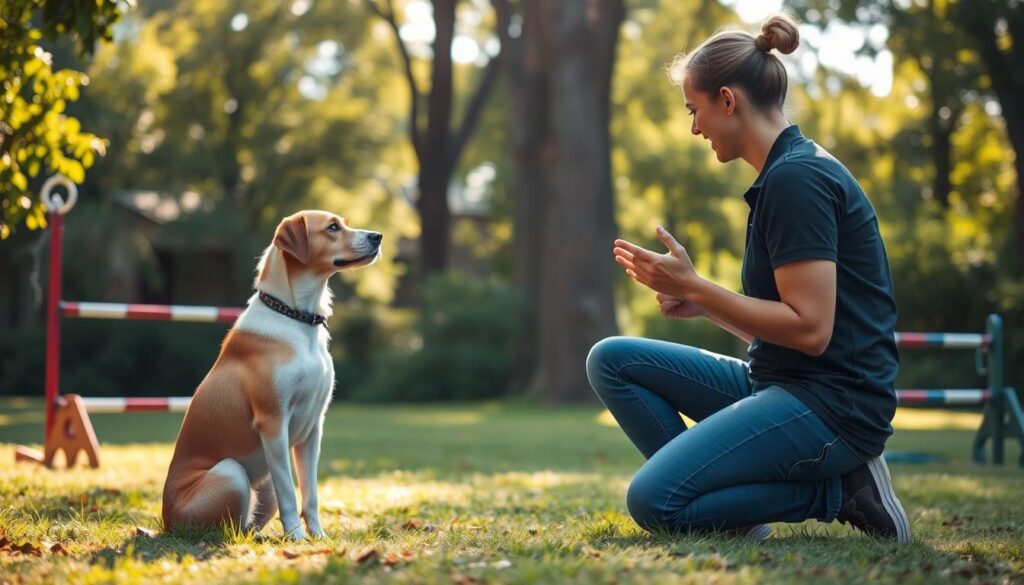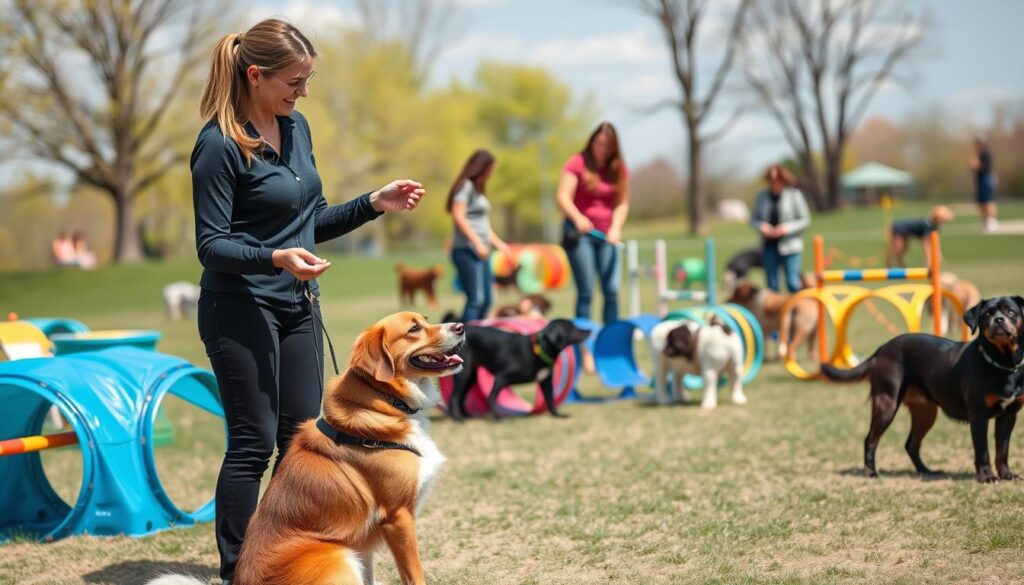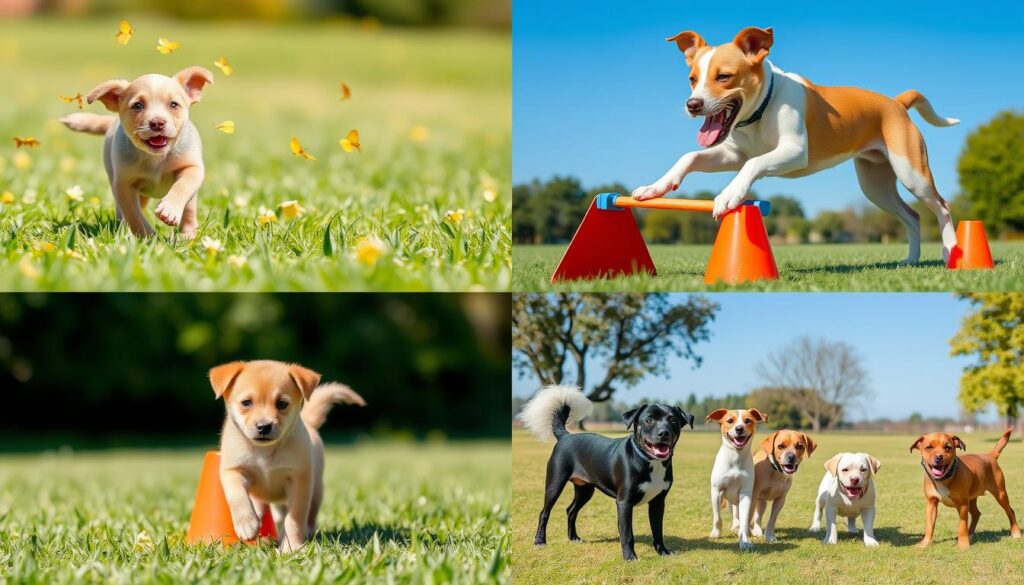Did you know dogs that get regular training are 89% more likely to listen than those that don’t? This shows how important it is to find the best training schedule for your dog. As a dog owner, I’ve always wondered what the perfect training frequency is.
Getting the right balance in your dog’s training routine can change their behavior and obedience a lot. Whether you have a new puppy or an older dog, knowing the best training schedule is critical to success.
I’ve found that the secret to good dog training is being consistent and making it fit your dog’s needs. By focusing on basic skills and adding play, you can make a training program that keeps your dog interested and eager to learn.
Key Takeaways
- Consistent training significantly improves a dog’s response to commands
- Two main training sessions per day are recommended for optimal results
- Focus on teaching fundamental skills like stay, heel, and recall
- Incorporate play sessions to build cooperation and strengthen your bond
- Adjust your training approach based on your dog’s progress and motivation
- Short, frequent training sessions are more effective than long, infrequent ones
Understanding the Basics of Dog Training Frequency

Dog training frequency is important. It affects how well your dog learns and remembers commands. Consistent training makes dogs happy to learn. We will learn why it’s important and clear up some dog training myths.
Why Training Frequency Matters
A good training schedule is essential for your dog’s success. A study by Demant et al (2011) with 44 beagles showed interesting results:
- Dogs trained 1-2 times weekly did better than those trained daily
- Shorter sessions were more effective for long-term memory
- All dogs learned to recall commands after four weeks, no matter the training
Common Misconceptions About Training Frequency
Many think longer sessions are always better. But, short, focused sessions often work best. Ideal training times start at 30-60 seconds, then grow to 5-15 minutes. It’s important to give dogs plenty of rest to avoid stress and burnout.
Another myth is that daily training is needed. But, research shows dogs trained 1-2 times weekly learn faster than those trained every day. The most critical factor is in the quality, not how much you train.
Every dog is different. Adjust your training to fit your dog’s focus and energy. Mix commands into daily routines like meal times or walks. This makes learning faster by using everyday life as rewards.
Research Insights on Training Frequency

Dog training research offers interesting findings on how often to train dogs. Studies found that dogs trained once a week learn faster than those trained five times a week. The latter group needed almost 50% more time to learn.
Studies on Optimal Training Frequency
A study on Beagles looked at different training schedules. Dogs trained once or twice a week with one session did best. Those trained five days a week with three sessions struggled the most.
This suggests that less frequent, focused sessions might work better than daily intense training.
Understanding Individual Dog Needs
Creating personalized training plans is crucial to success. Dogs with long daily sessions finished courses in under 4 weeks. But those with short, bi-weekly sessions took 9 weeks but did twice as well.
For pet dogs, 5-15 minute sessions once or twice a day, a couple days a week, often work well.
Breed-specific training is also important. The Beagle study is valuable but may not apply to all breeds or training goals. It’s vital to adjust training frequency based on each dog’s unique needs, like age, temperament, and learning style.
Research also shows that consistent training reduces stress in dogs. Trained dogs have lower cortisol levels, less anxiety, and better social behavior. Regular training boosts cognitive functions, memory, and strengthens the bond between dogs and their owners.
Recommended Training Frequencies

How often you train your dog is vital to their learning. I suggest making a daily and weekly training plan that fits your dog’s needs and your life.
Daily Training Sessions
Short, focused sessions are best for daily training. Try 1-5 minute sessions several times a day. This keeps your dog interested without getting too tired.
Studies show dogs trained five times a week learn faster. They can pick up new tasks in about two weeks.
Weekly Training Sessions
For weekly training, aim for longer sessions of 15-30 minutes, 2-3 times a week. Research shows dogs trained once a week take 6-7 weeks to learn but remember better.
They learn tasks in fewer sessions, about 6.6 compared to 9 for dogs trained daily.
Balancing Multiple Sessions
When you have multiple training sessions a day, spread them out. Mix training with play and rest. This prevents your dog from getting too tired and keeps them eager to learn.
Remember, it’s not how often you train but how consistently. Pick a training schedule that works for you and stick to it.
| Training Type | Session Length | Frequency | Benefits |
|---|---|---|---|
| Daily | 1-5 minutes | Multiple times daily | Faster skill acquisition |
| Weekly | 15-30 minutes | 2-3 times weekly | Better skill retention |
| Multiple Daily | 1-5 minutes | 2-3 times daily | Balanced learning, prevents burnout |
Daily training sessions

Daily dog training routines are important to teaching dogs well. I make sure my dog learns and remembers new things by sticking to a schedule. Training sessions are short, lasting 5-15 minutes.
I plan my daily dog training routine around two main times, like when we eat. This way, I can use food as rewards, making training fun for my dog.
In these short training sessions, I teach one skill at a time. As my dog gets better, I mix skills to keep things interesting and prevent boredom.
Consistent dog training has many benefits. It helps us follow a routine, makes learning stick, and strengthens our bond. By adding training to our daily life, we get lots of chances to learn and get rewards.
| Training Aspect | Recommended Duration | Frequency |
|---|---|---|
| Basic Obedience | 10-15 minutes | Once daily |
| New Skill Learning | 5-10 minutes | Twice daily |
| Skill Maintenance | 5-10 minutes | Once daily |
| Working Dog Training | 30+ minutes | Daily |
Every dog is different. I tailor my training to fit my dog’s breed, age, and needs. Keeping training positive and consistent helps us both succeed.
Weekly training sessions

Weekly training sessions are crucial for a dog’s long-term growth. They’re great for dogs who know basic commands or need to learn advanced ones. These sessions last 15-30 minutes, making them more in-depth.
Longer sessions help with complex behaviors that need extra time. This is perfect for older dogs or those already good at basic commands. To keep things moving, I make sure to be consistent. I also mix in shorter daily practices.
| Session Type | Duration | Focus |
|---|---|---|
| Weekly Intensive | 15-30 minutes | Complex behaviors, advanced skills |
| Daily Maintenance | 5-10 minutes | Reinforcing learned behaviors |
A 5-day training week with two rest days is best for most dogs. It balances intense training with breaks to avoid burnout. For working dogs or those in competitions, I might train more often. I always watch how they’re doing and adjust as needed.
Consistency and knowing your dog’s needs are crucial for weekly training success. Adding these longer sessions to your routine will help your dog improve steadily over time.
Balancing multiple sessions per day

I spread out dog training sessions all day to keep things balanced. This way, my dog doesn’t get too tired or stressed.
My day has two big training times: one in the morning and another at night. I also sneak in quick training moments to keep things fresh.
Meal times are great for training. I teach commands and good manners during these times. Playtime is also important, as it strengthens our bond and offers more training chances.
I adjust how long each session lasts based on my dog’s energy and focus. This flexible plan mixes structured training with spontaneous learning.
| Time | Activity | Duration |
|---|---|---|
| 7:00 AM | Morning training session | 15 minutes |
| 12:00 PM | Lunchtime training | 5-10 minutes |
| 3:00 PM | Play and training | 20 minutes |
| 7:00 PM | Evening training session | 15 minutes |
This balanced schedule helps my dog learn without getting tired. By training throughout the day, we make it a natural part of our life together.
Structuring Effective Training Sessions

Creating effective dog training sessions means figuring out the right time and setting a positive vibe. The time needed changes with a dog’s age and focus. Puppies start with short 1-2 minute sessions, growing longer as they focus better. Adult dogs can handle up to 30 minutes.
Determining Session Length
The secret to effective dog training techniques is matching the session length to your dog’s needs. Young puppies can only focus for about 5 minutes, so I keep their training short and often. Older or more experienced dogs can handle longer sessions, up to 30 minutes.
I’ve found that breaking a 15-minute session into three 5-minute parts with breaks helps keep focus and productivity high.
Creating a Positive Training Environment
To make sure sessions are effective, I focus on creating a positive environment. This means using high-value rewards, lots of praise, and fun activities. I also change where we train to help dogs learn in different places. Always ending on a positive note keeps them excited for the next session.
| Dog Age | Recommended Session Length | Training Frequency |
|---|---|---|
| Puppies | 1-5 minutes | Multiple short sessions daily |
| Adult Dogs | 15-30 minutes | 4-5 days a week |
| Experienced Dogs | Up to 60 minutes | 3-4 times a week |
By paying attention to these details, dogs stay interested and eager to learn. This makes our training sessions both fun and effective.
Real-Life Training Opportunities

Real-life training is a hands-on way to teach your dog. It involves training during daily activities. This method helps your dog learn consistently and apply what they’ve learned in different situations.
Incorporating training into everyday activities
There are many chances to train your dog in your daily life. Use times like meals, walks, and play to teach new things. For example, teach your dog to wait before meals or to leave things alone during walks. These moments of practical dog training make your dog understand commands better.
Recognizing teachable moments
Teachable moments pop up all day long. Keep treats or toys ready for quick training sessions. When your dog acts well, give them a treat right away. This makes them want to do it again.
| Daily Activity | Training Opportunity | Skill Practiced |
|---|---|---|
| Mealtime | Wait before eating | Impulse control |
| Walks | Heel command | Leash manners |
| Doorbell rings | Stay in place | Self-control |
| Playtime | “Drop it” command | Object release |
By using everyday moments for training, you make learning a constant part of your dog’s life. This practical approach to dog training helps your dog remember and use what they’ve learned in real life.
Addressing Common Challenges in Training Frequency

Dog training can face hurdles like inconsistent schedules and keeping up with training. I know these problems can be tough, but there are solutions.
Managing inconsistent schedules
It’s hard to balance work, family, and training. I’ve learned that a flexible routine is key. When time is tight, I use short 5-10 minute sessions to practice commands.
This method keeps training consistent without overloading your schedule.
To keep training on track, I weave lessons into daily life. For instance, I practice “sit” before meals or “stay” when I leave for work. This turns daily moments into training chances, helping to beat training hurdles.
Recognizing signs of burnout or frustration
Look out for burnout in your dog:
– Lack of focus
– Avoidance behaviors
– Less enthusiasm
If you see these signs, change your training schedule. Take breaks and mix up activities to keep things fresh. Remember, it’s the consistency in how you train that counts, not strict schedules. By adjusting your training to fit your life, you can keep making progress and tackle common dog training challenges.
Alternatives to Traditional Training Methods
Exploring new ways to train dogs can help with specific issues or advanced goals. Professional dog trainers bring specialized skills to the table. Understanding dog aggression and other challenges often needs expert advice.
Exploring Professional Help
Private trainers, group classes, and workshops offer customized training. They use science-based and positive reinforcement methods that work well. For example, clicker training uses a sound device to mark good behavior, improving communication between dog and owner.
Utilizing Technology for Support
Dog training apps have changed pet education. They offer schedules, reminders, and tracking progress, helping keep training consistent. Some apps even offer virtual training sessions for remote access to experts. Interactive toys and treat dispensers also help, combining old and new methods for a complete approach.
By mixing professional help with technology, we can tailor training to each dog and owner’s needs. This approach focuses on their unique bond, leading to better and more fun training sessions for everyone.


